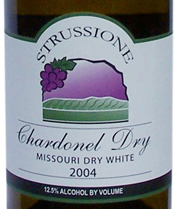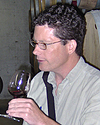

Cave Vineyard - Strussione Wines
2004 Chardonel Dry(Missouri)
The Russian painter Wassily Kandinsky wrote that, in spiritually sophisticated people, color can produce “a vibration from the soul.” I feel that way with words. For example, when I hear the term “hand-hewn,” I immediately think of something—ceiling beams, steps to an old church—that has mystery and texture. Synonyms such as “hand-made” or “artisanal” don’t do it for me, the former seeming inane and the latter merely evidence of a clever marketing department.
Marty and his family tend 14 acres of vineyard planted with 4 varieties. He works Chardonel 4 different ways (dry, off dry, sweet, late harvest). Winery operations are kept simple, and Marty is eager to hear what visitors think of his wine. The old saltpeter cave on the property (200 feet from the tasting room) is a unique place to sit and split a chilled bottle of dry Chardonel with a friend.
The 2004 Strussione Chardonel Dry from Cave Vineyards is a “hand-hewn” wine. Marty Strussion barreled it briefly and knew when to rack it our before the oak overcame the light honeydew tones. The oaked Chardonel nose carries the mystery of cellars and caves, delicate melon tastes are almost palpable, and the finish is smooth, revealing a very slight diacetyl butteriness. Wine like this cannot be mass-produced; it is hand-hewn.
Reviewed July 12, 2007 by Tim Pingelton.
The Wine
Winery: Cave Vineyard - Strussione Wines |
The Reviewer Tim Pingelton
Tim Pingelton
As a professional winemaker and writer, Tim Pingelton understands how growing conditions and vinification techniques affect the grapes as they become wine. As an Appellation America correspondent, he realizes that a balance must be struck between standards in flux and standards fixed in time. Tim continually explores the areas about which he writes to personally relate how their wines do or do not embody appellation-specific characteristics. |










